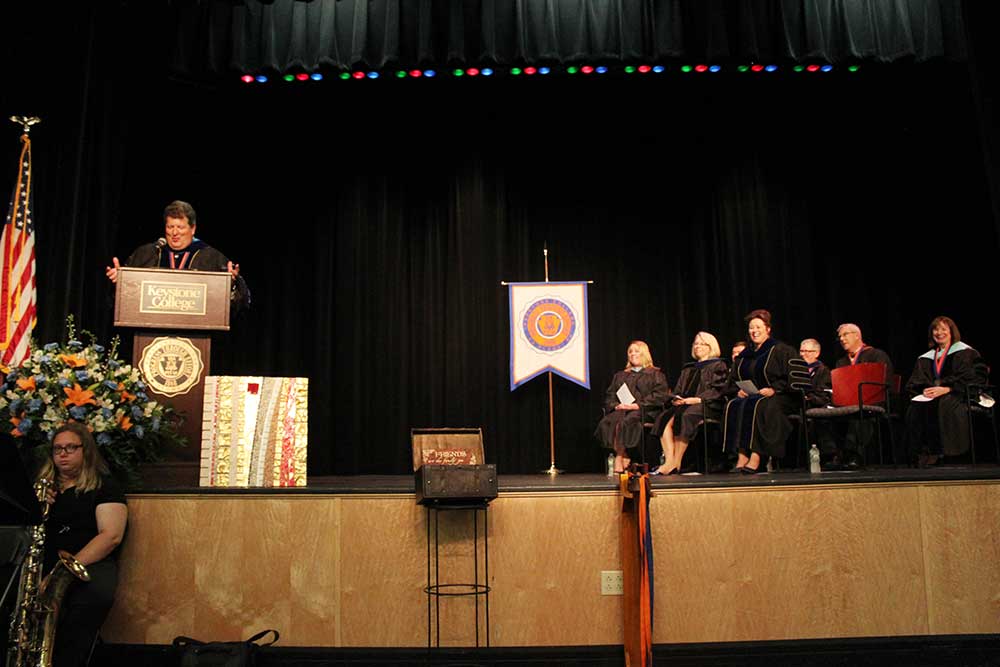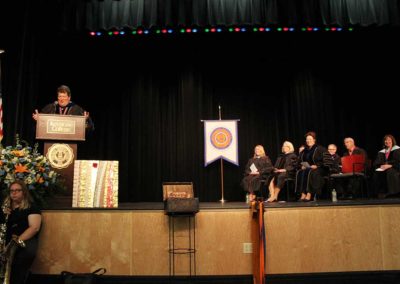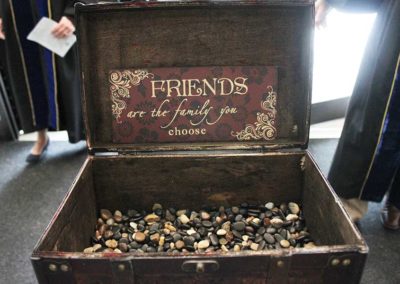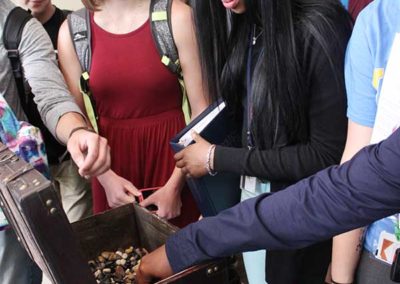Stones: Story and Destiny

Photo caption: Keystone President Dr. David L. Coppola welcomes first-year students and celebrated the official opening of the 2017-2018 academic year at Opening Convocation on August 31, 2017.
Keystone College Opening Convocation 2017
As a young boy, growing up in northern New Jersey, my brothers and I worked with my father in the summers improving our yard. A favorite pastime was building walls. I was astonished to learn at the youngest age that there is skill and planning necessary to build a stone wall. One has to decide will the wall be wet; i.e., will it be constructed with cement, or dry. Then, is the wall to retain dirt or would its destiny be a two-sided wall to help frame an edge for a yard or garden? Then, there is the choice of the stone. Is it a front-facing stone or a filler, and does it best fit horizontally or vertically? Sometimes, our neighbor, Mr. Nardone, who was a professional landscaper whom everyone called “Sonny,” would come and offer his commentary and stories. His hands were thick and rough, but his advice was clear and helpful. He believed that every stone was important and had a story and would eventually fit somewhere. He gave me my first lawn-cutting job as a teenager, and I still remember his laughter and some of his stories today.
Stones are all around us.
Stones are all around us. Students, perhaps you have noticed the stone walls for which Pennsylvania is famous, or perhaps you have been conscripted on a summer’s day to build or repair walls with your father or family? In a 2004 book, Mission and Place, (American Council on Education and Praeger), the authors and architects (Kenney, Dumont, & Kenney), make a compelling case for planning space on college campuses based on the mission. In their view, buildings and spaces should be created intentionally to promote learning and engage students in the pursuit of knowledge, understanding, and truth. At Keystone, we have adopted this place-making philosophy, beginning with Jake’s Fire-pit up at the Eckel Family Pavilion and at Boehm Hall, where we have created low walls that are made from numerous stones, symbolizing our unity-in-diversity. These low stone walls capped with Pennsylvania Blue Stone are intended to be places to gather and talk, rather than walls that keep people apart.
At Keystone College, we are part of a liberal arts tradition that invites us to build a democracy that is made up of an educated and ethical citizenry. This tradition values the rule of law with associated rights and responsibilities, mutual respect, private and public security, diversity, and ethical engagement for the common good. We are not organized into the institutional, curricular scaffolding of traditional liberal arts colleges, where there are discrete academic departments in philosophy that require grammar, logic, and rhetoric, or history, religious studies, music, astronomy, or even Greek, Latin, and other ancient and world languages. But through our signature 4-year development process we call “Stairs to Success,” each one of you is encouraged by our excellent faculty and staff to seek out your fullest potential by developing a) critical and creative thinking, b) clear and careful communication, c) competencies and the appropriate skills to pursue meaningful careers of your choice, and d) virtues that promote ethical problem-solving. This summarizes our roots in the liberal arts tradition at Keystone, and we believe that each one of you is important, has a story to share, and can live and learn together. When we join together for the right reasons, then the strength of friendship forms a stone-solid foundation for a vibrant community, and you will have begun to break down the walls of ignorance and prejudice, and contributed to the good society.
There are hundreds of small rural colleges like us in the United States and what is common and distinctive to all of us is that we care about your success as a student—and your growth as a person. We practice a philosophy of servant leadership—a phrase coined by Robert Greenleaf in his 1970 essay and later in his 1977 book, Servant Leadership (Paulist Press). Servant leadership has deep roots, often attributed to Lao-Tzu in China in the 6th Century BCE (570-490), and is found in many religious texts including the Hebrew Scriptures, the Qu’ran, and the teachings of Jesus of Nazareth, although the philosophy itself transcends any particular religious tradition.
We are servants first, and we are focused primarily on your growth and well-being
I invite you to look around. In this brightly-colored room of academic regalia, you can see that we possess a great deal of experience, authority, and expertise. As servant leaders—faculty, staff, and administration—we are servants first, and we are focused primarily on your growth and well-being. This inspires all of us to work together and sacrifice for your success, and by extension, the common good. It is true that as a community of educators and scholars, we must strive for excellence in scholarship, which has often been affirmed by our accreditors and peers. However, the primary motivation for being here at Keystone is not for our own recognition or self-glorification; rather, we find our highest purpose in helping you to succeed by opening doors; modeling good teaching, scholarship, service, and ethical behavior; and by assisting you on your journey of the mind, soul, heart, and hands.
We celebrate the beginning of your journey to achieve your goals and dreams.
Today, we celebrate the beginning of your journey to achieve your goals and dreams—even if they are only dimly perceived at this time. If you are uncertain, undeclared, or just a little hesitant, don’t worry because we believe in you.
Today, we confidently pass on the scrolls of matriculation that symbolize our promise of servant leadership with you. Our Latin motto [via fit-vi] that we translate as “progress through effort,” challenges us to be ambitious, do our best, and to work to build a better world together. The result will be steady and fulfilling progress. You belong here.
Today, we feel your excitement, enthusiasm, and energy. [Some of you have been playing basketball outside my window at 11pm—keep it up!] We see and celebrate you as young people who are growing and developing. Thankfully, the values and virtues promoted here will empower you to grow into responsible adults who can think freely and critically, communicate effectively, problem-solve with creativity, and act with justice and compassion. You will become your best selves here.
About ten years ago, I was fortunate to work with Marko Ivan Rupnik, a Slovenian Jesuit artist and theologian, and a dozen of his colleague-artists from Centro Aletti—an inter-cultural education and spirituality Center in Rome, that seeks to promote peace through dialogue and art. They were creating a 28 x 40-foot triptych mosaic at Sacred Heart University in Connecticut, where I was responsible for facilitating the three-week installation. At one point, I remember asking how he knew which of the tens-of-thousands of stones to use, and where to place them correctly. He replied, “Every stone has a story and a destiny to tell a greater story in the mosaic. This is the iconic mystery of love and wisdom.” I wrote that down because I knew I would share those words again someday, as I have done today.
Marko and I shared several meals and conversations together, and at one point we discussed education. We agreed that the best way to pursue both wisdom and virtue was through openness to dialogue—especially with those of different beliefs and cultures. From this humble posture (reminiscent of servant leadership), he believed that the efforts of teachers would gently leave fingerprints on the clay of humanity (cp. Genesis 2:7) but also transcend us, like the smoke from burning incense that rises through our selfless, good works “into the heart of the heart of love.” Marko created a small mosaic for me to remind me (and now all of us gathered today) of this conversation. As you can see, this mosaic includes stones from several parts of the world (to represent diversity), as well as hand-molded terracotta squares (representing humanity), and sparkling shards of glass that recall the brokenness of humanity that look like the smoke of incense leading to a red box (the heart of love). This philosophical and artistic vision is a lot to live up to, but it is a hopeful story of education and our destiny told through these stones.
We do not judge people or throw stones here, nor do we build walls to keep people out.
So, on your way out today, I invite each of you to take a stone or two with you to remind you to learn and work together, to be there for each other. All of us carry challenges and burdens in our hearts, but we are not alone. Feel free to call these “story stones,” or “destiny stones,” or “touchstones,” and share, trade, or simply carry them in your pocket. Most of all, remember that we do not judge people or throw stones here, nor do we build walls to keep people out. Rather, these are symbolic stones of celebration where we connect our individual stories to the larger story of Keystone College’s 149-year history, and we bring all of those experiences, all of those shiny, precious, diverse stones together. We join the stones of our lives into a story and a common destiny—a mosaic of meanings: beautiful, hopeful, imaginative—all on a journey towards love and wisdom.
I challenge you to make the most of your experiences here at Keystone College.
Get involved.
Fall in love with learning.
Work together and share your stories freely.
We believe in you and look forward to hearing your stories.
You belong here with all of your gifts and diversity.
It is your destiny to become your best as Keystone College students and future alumni.
We officially welcome you to the Keystone College community!
President David L. Coppola, Ph.D.








